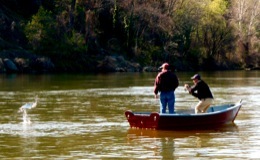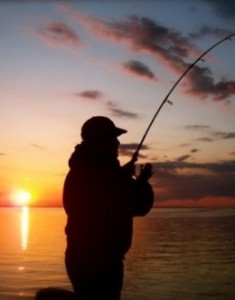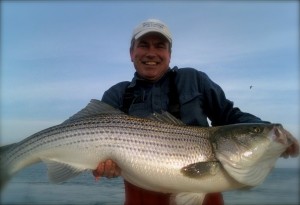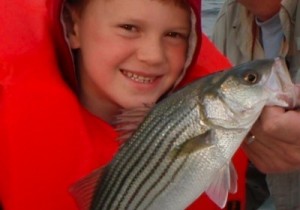
Like most anglers, I love to eat fish. One of my favorite family traditions is fish for breakfast. Occasionally when we have guests visiting, the fishermen in the house get up before everyone else and spend the daybreak hours on the water. If things go as planned, we’re back before the house starts to stir, preparing a delicious breakfast of eggs, grits, fresh tomatoes, homemade biscuits, and freshly caught fish. That being said, I don’t keep most of the fish I catch. By letting them go, I get the same satisfaction out of my fishing experiences while contributing to the sustainability of the sport I love.
The inclination toward releasing fish is fairly modern. Some Native American tribes believe that it is wrong to release a fish. According to their culture, the fish allows itself to be caught. It chooses to sacrifice its life to provide food for the angler. To release any part of it back into the water would dishonor the fish and result in poor fishing the following year. These beliefs were formed at a time when they speared, netted, trapped, or caught their fish with hand-made equipment, perseverance, and a little benevolence from the Great Spirit.
Today, the debate over what to do with the fish we catch has become less spiritual and more about conservation. Technological advances in fish harvesting techniques such as sonar, GPS, graphite rods, and holographic lures, have gotten us to the place where some species are close to extinction because of overfishing. To counter this, state and federal governments limit the number of endangered fish that can be caught and restrict the commercial and recreational methods by which they can be harvested.
Catch-and-Release Philosophy
One conservation method used to protect fish is commonly referred to as catch-and-release. Sometimes it’s called selective harvest or delayed harvest. Catch-and-release as a management technique is relatively new in the United States. Some point to Lee Wulff as the father of the modern catch-and-release perspective. A master fly fisherman, author, and artist who promoted angling ethics in the mid-twentieth century, he wrote, “a gamefish is too valuable to be caught only once.” 
Catch-and-release fishing, however, has been around as long as humans have been pulling fish out of water – it’s human nature to want to catch bigger fish, whether they are for sustenance or sport. While barbless hooks dating to 1000 B.C. have been found in Europe and in parts of the Orient, I like to imagine Adam, fishing with a cane pole in a clear stream flowing through the Garden of Eden. In my mind, he lands his first fish and shouts back over his shoulder to Eve, “Too small, I’ll try for a bigger one.”
Although increasing in popularity, catch-and-release fishing is still a novel concept in the United States. Out of over 40 million U.S. anglers, only a fraction release the fish they catch. Most fishermen would never consider releasing a targeted species until they catch the legal limit. Some traditionalists consider those who espouse catch-and-release to be elitist, and perceive it their God-given right to bring home fish.
Here on the Chesapeake Bay, a change toward more conservative fishing has been especially slow. Fish are routinely over-harvested; often by illegal methods while state judicial systems look the other way. I’ve met many fishermen – including some charter boat captains – who keep every fish they catch without any consideration of the consequences. There’s even a recent initiative by one charter boat association to ban winter catch-and-release-fishing altogether. Fishing as a meat-only enterprise has been a way of life on the Bay for centuries. Old habits – like the fish they kill – die hard.
The catch-and-release debate is often characterized in the language of the animal rights movement. In some European countries opponents believe it is cruel to catch fish only for enjoyment. Switzerland has even banned sport fishing altogether believing that the only valid reason to catch fish is for human consumption. Often the debate centers on whether fish feel pain. Proponents argue that fish do not have the neurological capacity to feel pain, or that a fish’s mouth must be tough and desensitized because of the spiny forage they consume. Opponents cite studies showing that sensory receptors inside a fish’s mouth allow them to feel a certain amount of pain. For example, scientists in Liverpool, England injected bee venom and acid into fishes’ mouths and found a stimulus response at 58 independent receptors. Their study also documented a significant increase in the time it takes for a fish to resume feeding after receiving the pain stimulus.
I don’t doubt the validity of these studies. Any fishermen who’s ever fought a hooked-up fish as it struggles to get off the line knows intuitively that it hurts a fish to get caught. It’s what keeps it from striking a lure again once it feels the hooks. In over 40 years of fishing, however, I’ve taken enough fish off a hook and observed them swimming away to draw a reasonable conclusion that their pain receptors are significantly less than those of humans.
Survival Factors
 Regardless of how you come down in the philosophical debate, two things are inevitable: first, every angler – even the most die-hard proponents of the keep-what-you-catch school – will have to release some fish, whether they are too small, too large, diseased, or prohibited; and second, that some fish will die after catch-and-release. Some scientific studies have shown that as many as 10 percent of hook-caught fish die after they are released, while others put the rate much lower. There isn’t a lot of scientific data about the survival rates of individual species. We don’t know how the same stress placed on a rainbow trout might impact a largemouth bass, or how the survivability of a striped bass compares with a Coho salmon.
Regardless of how you come down in the philosophical debate, two things are inevitable: first, every angler – even the most die-hard proponents of the keep-what-you-catch school – will have to release some fish, whether they are too small, too large, diseased, or prohibited; and second, that some fish will die after catch-and-release. Some scientific studies have shown that as many as 10 percent of hook-caught fish die after they are released, while others put the rate much lower. There isn’t a lot of scientific data about the survival rates of individual species. We don’t know how the same stress placed on a rainbow trout might impact a largemouth bass, or how the survivability of a striped bass compares with a Coho salmon.
The evidence is clear, however, that a released fish’s chances for survival greatly increase with proper handling. Both the choice of tackle used to catch and the method used to release a fish has a significant impact on whether it survives. A study of catch-and-release mortality by University of Maryland researchers found that optimized techniques and careful handling could result in a significant reduction in the number of line-caught fish that die after being released. The study shows that up to 99 percent of the fish survive when they are caught, handled, and released properly. In winter months when water temperatures are low, survival rates are highest.
In the end, each individual bears the responsibility for the well-being of the fish that they catch. It’s up to each of us to develop our own personal angling ethics. Since it’s inevitable that every fisherman will release fish at some time, it is important to take as many steps as possible to ensure the fish we release survive. As anglers, we control four basic factors that affect a fish’s chance of survival after release. They are:
· Exhaustion – The fight is tough on the fish. It can upset the fish’s chemical balance if it lasts too long.
· Loss of Slime – Fish have a slime coating that seals out infection. Rough handling can destroy this protective layer.
· Time out of the Water – As long as a fish is out of the water, it can’t breathe or restore its chemical balance.
· Wounds – Damage caused by hooks or rough handling may result in mortal damage. According to the most recent research, fish mortality is directly related to where it is hooked. Fish that are deeply hooked or have damage to their eyes or gills are the least likely to survive.
Size Matters for Conservation, Too
 In most cases, releasing fish helps conserve populations. This is especially true with the biggest fish of spawning age. They are generally the most valuable spawners: a 30-pound striper can produce 1.5 million more eggs than a 10-pounder. Every fish is a potential spawner, but since stripers spawn in March through May, harvesting roe-laden females in the spring can be especially detrimental to the population.
In most cases, releasing fish helps conserve populations. This is especially true with the biggest fish of spawning age. They are generally the most valuable spawners: a 30-pound striper can produce 1.5 million more eggs than a 10-pounder. Every fish is a potential spawner, but since stripers spawn in March through May, harvesting roe-laden females in the spring can be especially detrimental to the population.
Most of the bigger rockfish spend their lives in the cool waters of the Atlantic, far north of the state waters of Maryland. Their annual migration to the spawning grounds at the headwaters of the Bay prompted fisheries management officials to authorize a special spring “trophy season.” In theory, restrictions set by the DNR limit the number of big fish harvested. In practice, however, spring trophy season is one of the most popular times to fish in the Bay. Most springtime anglers troll heavy tackle with multiple lines, greatly increasing the number of big fish killed in recent years. The damage done by killing a spawning fish is irreversible.
Big migrating stripers don’t taste as good as smaller fish, and they probably shouldn’t be eaten. According to a recent advisory posted by state agencies up and down the Atlantic seaboard including the Maryland Department of the Environment, coastal striped contain high levels of PCBs and other toxic substances. Pregnant women, women of childbearing age, nursing mothers, and children 6 and younger should avoid the fish altogether. Yet, fishermen routinely kill the big fish and take them home to feed to the family. It’s better for the fish and the fisherman to let them go.
A Picture’s Worth a Thousand Fish
An option to catching and killing trophy fish is to take pictures. It’s said that a picture is worth a thousand words. In the case of early spring fishing on the Bay, it just may be worth a thousand fish. A digital photograph is excellent proof of a successful catch. It’s also all you need – along with a couple measurements for length and girth – to create a lifelike fiberglass wall mount. These replicas often look better and last longer than traditional taxidermy, and come with the added satisfaction of knowing that your trophy fish is still repopulating the Bay.
Maryland also allows catch-and-release fishing during the winter months after the regular fishing season is closed. In my experience, winter is the best time of the year for a light tackle fisherman to fish the Chesapeake Bay. The water is clean, cold, full of big fish, and virtually empty of boats. The very low water temperatures greatly increase the odds that winter-released fish will survive after release. Off-season catch-and-release is one of the great benefits to living near the Bay.
Planning Ahead
One of the keys to careful angling is planning ahead. Before putting a line in the water, decide what to keep for trophy or dinner. Have the tools and tackle necessary for properly releasing fish. Here are some steps in planning ahead:
· Use sufficient tackle – Sufficient tackle can include light tackle. I’ve caught numerous fish over 40 inches in length and I can’t remember a single fight lasting over five minutes. Fish caught casting are usually landed faster than those that are pulled through the wake of a trolling boat. With good gear and a tight drag you minimize damage caused by exhaustion. Check your knots carefully and retie often so you don’t break off a big fish and leave the lure in its mouth.
· Use artificial baits whenever possible – The basic concept of light tackle fishing centers on the use of artificial lures. Fish tend to swallow natural baits, but they are usually hooked in the lip or mouth with artificial baits. Fish caught in the mouth are much more likely to survive than deeply hooked fish.
· Use barbless hooks – This makes as much sense for the fisherman as it does the fish. In my years of fishing I’ve had several hooks removed from various parts of my body. Some of the removals required a trip to the emergency room and surgery. If you fish a lot, you’re inevitably going to get yourself hooked. Count on it. But a barbless hook can be easily removed both from the fisherman and the fish. For the fish, this means less time out of the water and a better chance of survival. Sometimes all that is necessary to release a fish on a barbless hook is a slack line. Barbs can easily be bent or filed down on either bait hooks or artificial lures.
· Use circle hooks when fishing with bait – Studies have shown that circle hooks minimize gut-hooked fish. A study conducted by the Maryland Department of Natural Resources shows that deep hooking rates for conventional J hooks was 17.2 percent while the rate using non-offset circle hooks was only 3.4 percent. Circle hooks are the easiest way to bait fish. All you do is let the fish take the bait and start reeling.
· Reduce the use of treble hooks – Often, single hooks can replace trebles or tines can be clipped without ruining the action of the lure. I’ve found that with some experimentation, you can actually improve the action of some lures by using single hooks. Lures that are designed to be vertically jigged can almost always be improved with single hooks. Replace the trebles on your stingsilvers, spoons, and diamond jigs and you’ll dramatically increase your chances of catching fish.
Careful Release
According to the Chesapeake Bay Foundation, it’s best if a fish is released without ever leaving the water. This prevents loss of slime and eliminates the possibility of injury once the fish comes onboard the boat. Here are some of their tips:
· Use the right tools – Remove hooks from inside the fish’s mouth, gill, or gullet with tools like forceps or needle nose pliers. Barbless hooks make this process much easier.
· Use a dehooker – When the hook is in the stomach use a degorger or deep throat style dehooker. It’s easy to make a bent-wire dehooker out of a coat hanger. Commercially designed ones are inexpensive and readily available at any bait shop or sporting goods store.
· Remove the fish carefully by supporting its weight – If you take the fish out of the water for a picture, keep it upright by putting your wet hands under the fish’s belly and lifting it straight up.
· Avoid landing nets – If you must use a net, use the knotless rubber type. These minimize slime loss and will reduce wounding. Net mesh nets split the fishes tails and fins.
· Keep control of the fish – Big striped bass will be stronger than you think once they get onboard the boat. Do your best not to drop it or let it flop around on the deck. Covering the fish’s eyes with a towel often calms it and keeps it from flopping. A good way to help immobilize the fish once it’s horizontally supported is with a commercial boga grip.
· Handle fish carefully – Wet hands before picking up the fish. Wet gloves can be helpful to reduce wounding and slime loss. They can also help you maintain control of the fish.
· Cover the fish’s eyes – This will calm the fish and reduce flopping.
· Avoid the eyes and gills – These body parts are especially delicate and prone to infection. Also, the gills provide intake of oxygen and salts from the water after the fight. Protect them.
· Carefully return the fish to the water – After removing the hook, hold the fish close to the water and release it upright and head first. If you can’t get the hook out, cut the line and leave the hook. Studies show that fish can survive while a hook rusts away and some can even be passed through the digestive system.
· Revive unresponsive fish – Move the fish gently forward so that water passes over its gills and relieves exhaustion. If a fish is obviously injured, keep it for dinner and adjust your fishing so you don’t make the same mistake again.
Fishermen Saving the Bay
I am fortunate to fish in the Chesapeake Bay, a diverse ecosystem with many species of fish to target. For many years, the health of the Bay has been threatened by industrial pollution, suburban sprawl, agricultural runoff, and overfishing. Despite hundreds of federal, state, and local regulations to reverse the damage, by all measures, we’re still fighting to “Save the Bay.”
I listen to old-timers with awe, and often wonder how many fish I could catch if the Bay were not polluted. As fishermen, we are the first people affected by water pollution. When fish habitat is destroyed, there are fewer fish for commercial, charter, and recreational fishermen to catch. We should be working the hardest to prevent pollution and conserve fish.
The best thing we can do is lead by example. By being very careful in the way we treat the Bay, we can encourage others to change their ways. I’ve included the Chesapeake Bay Foundation’s Fishermen’s Code. It is a set of guidelines to help fishermen treat the Bay with respect.
The Fisherman’s Code for Protecting the Chesapeake Bay
1. Abide by fishing regulations – Overfishing reduces next year’s catch and disrupts the Bay’s food closely interlaced food web.
2. Carefully release unwanted fish – If we conserve our fish future generations can enjoy the Bay just as we do.
3. Dispose of old fishing gear onshore – Fishing line and nets discarded overboard entangle and kill marine life.
4. Collect all trash for disposal onshore – Keep a trashcan on the boat. Most ramps and marinas have dumpsters for trash collection.
5. Keep oil and gas out of water – Oil and gas are toxic to fish. Be careful when filling tanks and changing oil.
6. Contain human waste for onshore disposal – Pollution from human waste reduces water quality and closes areas to fishing.
7. Use antifouling paints with care – Paints and solvents can be very toxic to marine life.
8. Prevent cleaners from washing overboard – Even common cleaners cause pollution.
9. Save old antifreeze for onshore disposal – Antifreeze can be very toxic to fish.
10. Avoid boat speeds that cause large wakes – Boat wakes contribute to shoreline erosion and the loss of seagrass beds.
Anyone can practice the principles of careful catch and release on the Chesapeake Bay. It’s a proven tool to sustain fish populations and protect our sport for future generations. I’ve personally resolved to do a better job than what I’ve done in the past. With a one or two fish per day limit on the Bay, it doesn’t take long for a good angler to catch his or her limit. By catching and releasing, we can continue to fish and keep refining our techniques so that we become better at the sport we love. Most of the techniques that are good for the fish are even better for the fishermen.

Although I like to eat fish and keep some from time to time, I find an even deeper sense of satisfaction in releasing them. Part of that fulfillment is the knowledge that I am preserving valuable natural resources and contributing to the sustainability of the species I catch. Releasing a beautiful fish to live and swim away freely is the pinnacle of sportsmanship and one of the most satisfying experiences of life.
Portions of this article are reprinted with permission from the Careful Catch brochure produced by the Chesapeake Bay Foundation.
Lukacovic R. (1999) striped bass circle hook study. Maryland Department of Natural Resources [http://www.dnr.state.md.us/fisheries/fishingreport/crsb.html]




I’d like to voice my strong agreement to this article by offering my own suggestion to anyone struggling to convert to a “Catch & Release” fishing lifestyle.
While you SHOULD minimize the time a fish is out of the water, the next time you land a fish, large or small, take a moment to admire the fish. Look for distinguishing marks, and compare your catch to other fish you’ve caught. Pay particular attention to a fish’s varying color patterns. Stripers are, contrary to popular belief, hardly just “black and white.” I’ve caught bass on the Bay with amazingly diverse color combinations; blue, purple, red, orange, and even yellow overtones can be seen when the fish is held up to the sunlight. Often the smaller fish display prettier physical attributes.
By taking a moment to admire your catch, you’ll be hard pressed to not turn it loose. Besides, by getting in the habit of carefully scrutinizing your catch, you’ll likely find clues as to the fish’s eating habits and lifestyle, thus improving your fishing skills while enhancing fishing experience, simply by taking a moment to admire your handiwork. Tight lines.
PS
When you DO decide to keep and eat your catch, learn to fillet properly. This will minimize waste, and enhance taste. Also consider keeping the bones, bones, tail, and head to boil for fish stock, further minimizing waste while yielding an excellent base for soups and other dishes. Fish give us adrenaline-pumping thrills cast after cast. Pay them the respect they deserve by wasting as little as possible.